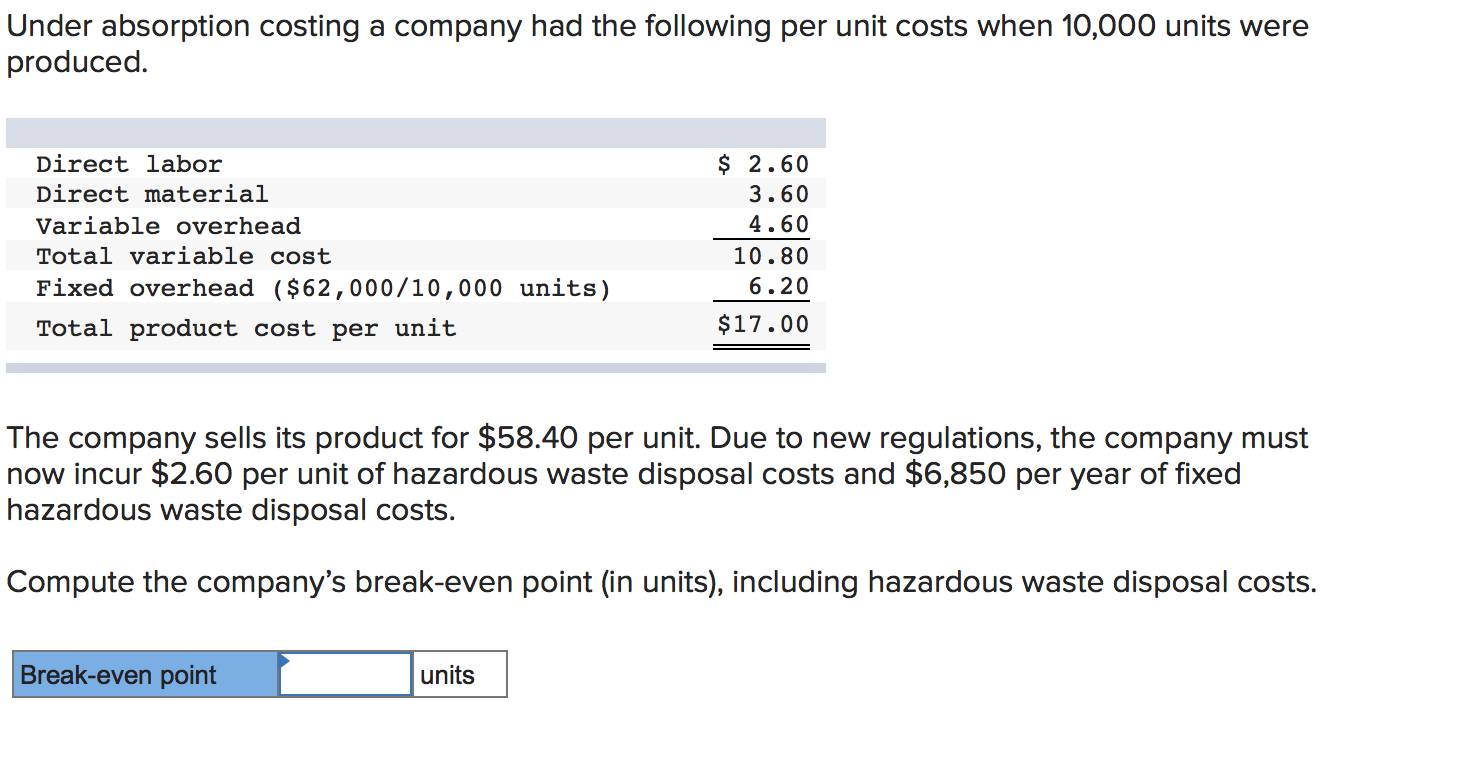
The adoption of absorption costing has direct implications for a company’s tax liabilities. Tax authorities typically require that inventory costs include both fixed and variable production costs, which aligns with the principles of absorption costing. This requirement ensures that expenses are not prematurely deducted for tax purposes, thereby deferring tax liabilities to the period when the inventory is actually sold.

Please Sign in to set this content as a favorite.
The company management should use it with diligence and responsibility so as not to create any negative effect in the decision making process. Since this method shows lower product costs than the pricing offered in the contract, the order should be accepted. At Finance Strategists, we partner with financial experts to ensure the accuracy of our financial content. If a job involves direct wages of $1,000, the overhead to be absorbed amounts to $500 (i.e., 50% of $1,000). The overhead rate is applied to determine the amount of overhead to be charged to a job.
- Therefore, ending inventory under absorption costingincludes $600 of fixed manufacturing overhead costs ($0.60 X 1,000units) and is valued at $600 more than under variable costing.
- Absorbed cost, also known as absorption cost, is a managerial accounting method that includes both the variable and fixed overhead costs of producing a particular product.
- As 8,000 widgets were sold, the total cost of goods sold is $56,000 ($7 total cost per unit × 8,000 widgets sold).
- Our writing and editorial staff are a team of experts holding advanced financial designations and have written for most major financial media publications.
- It is assuming that all cost types can allocate base on one overhead absorption rate.
Direct and Indirect Costs
It is a very common method used widely in the business especially in the manufacturing sector, and in this way the company is able to determine the cost of individual product and services. The why the xero app marketplace is so importanting method is typically the standard for most companies with COGS. Small businesses may also be required to use absorption costing for their tax reporting depending on their type of business structure.
Absorption Costing vs. Variable Costing Example
People often quote random numbers however, it is very important to determine what costing method will be used for a correct expense report. Absorption Costing therefore includes much more than the necessary variable (production) costs such as labour and raw material. The application of absorption costing extends across various sectors, each with its unique characteristics and cost structures. The method’s adaptability allows it to be tailored to the specific needs of different industries, from manufacturing to services and retail. The following subsections delve into how absorption costing is utilized within these diverse business environments.
When Is It Appropriate to Use Absorption Costing?
Absorption costing, alsocalled full costing, is what you are used to under GenerallyAccepted Accounting Principles. Under absorption costing, companiestreat all manufacturing costs, including both fixed and variablemanufacturing costs, as product costs. Remember, total variablecosts change proportionately with changes in total activity, whilefixed costs do not change as activity levels change. These variablemanufacturing costs are usually made up of direct materials,variable manufacturing overhead, and direct labor.
Our work has been directly cited by organizations including Entrepreneur, Business Insider, Investopedia, Forbes, CNBC, and many others. We follow strict ethical journalism practices, which includes presenting unbiased information and citing reliable, attributed resources. 11 Financial may only transact business in those states in which it is registered, or qualifies for an exemption or exclusion from registration requirements. 11 Financial’s website is limited to the dissemination of general information pertaining to its advisory services, together with access to additional investment-related information, publications, and links.
This method of overhead absorption refers to the application of overheads as a percentage of direct labor. The overhead rate can be determined by dividing the total estimated overheads of the cost center or job by the total estimated units of output. This is important for financial reporting and decision-making because it takes into account both variable and fixed production costs. This is the allocation of the cost of machinery and equipment over their useful life. Depreciation is considered a fixed cost in absorption costing because it remains constant regardless of production levels.
The main idea and intention behind using such a absorption costing method for costing purpose is to imply that a product, when produced, absorbs both fixed and variable cost up to a certain extent. It does not depend on the fact that the unit of the product has been sold or it is still lying in the storage as inventory or finished product ready to be sold. Based on what happens to the product, it will be considered under the inventory calculation or considered under sales revenue and profit calculation. The absorbed-cost method takes into account and combines—in other words, absorbs—all the manufacturing costs and expenses per unit of a produced item, ones incurred both directly and indirectly. Some accounting systems limit the absorbed cost strictly to fixed expenses, but others include costs that can fluctuate as well. Absorption costing, also known as full costing, is a method that accounts for all manufacturing costs, both fixed and variable, in the cost of a product.
